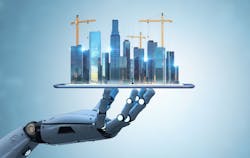Many industrial process operations deploy mobile robots for a variety of purposes. A “mission,” during which a robot travels to one or more specified locations in the plant, can be for visual inspection, sound detection, emissions or leak detection, thermographic inspections, a mapping survey, or routine surveillance that simulates an operator’s round.
Mobile robots can incorporate human-like capabilities, such as hearing, sight, smell and touch, which enable them to read gauges, record sound signatures, detect hot and cold spots, pinpoint leaks, determine valve positions, and detect abnormal objects.
In today’s era of staffing shortages, prospective users no longer need to wrestle with the idea of replacing human workers with machines. By performing lower value tasks, robots enable people to focus on strategic efforts that can’t be automated.
Mobile robots increase safety by reducing risks to the workforce. The “dirty and dangerous” assignments they perform keep people out of harm’s way. By venturing into hazardous areas, robots not only increase workforce safety, but they also increase productivity. Process operators have favorably compared the time and costs associated with robot deployments to preparing human workers with personal protective equipment (PPE) such as fire suits. This is particularly effective during night shifts. On missions such as operator rounds, robots have proven they can reduce errors and rework.
If we expand the definition of mobile robots to include drones, the benefits extend to include coverage of difficult-to-access locations. Most human workers are happy to forego climbing ladders on antennas, elevated water tanks, smokestacks and wind turbines.
For predictive and prescriptive management purposes, drones and mobile robots typically use artificial intelligence (AI) or machine learning to enable data analysis and fusion based on inputs from their payloads.
While many industrial process operations deploy or test them, use cases are still limited. Some users say one issue related to incorporating them into their standard operating procedures is time. The user experience, training, maintenance and proofs-of-concept (and value) have been very positive.
One of the primary challenges is that no one robot can do everything necessary. While the digital platforms in today’s drones and mobile robots are generally excellent, there are incompatibilities among models.
For an industry experiencing digital transformation, this creates the potential for more silos. Each robot has its own proprietary interface and type of data storage, on premise or in the cloud. A large data volume can be collected—but good data orchestration and analysis are necessary for predictive and actionable knowledge.
Questions remain about how robot data can be used by all the entities in the enterprise’s database such as the process control system. Ideally, the process control system could seamlessly exchange data with robots in real-time during missions.
Fortunately, a solution is available. Using a software platform for robot fleet management, the direction and data collection from multiple types of robots can be performed in a unified manner. In addition to asset performance management, robot-supplied data can be associated with control/safety systems and used for operational purposes.
By unifying data from all robots, this platform gives users a comprehensive visualization on one web browser. A dedicated viewer isn’t required. Media data collected by the robot, such as photos and audio, can be viewed live.
Regardless of the robot model, there is one, unified environment for user experience and enterprise data. This enables, not only digital transformation with mobile robots, but also autonomous operations.
About the Author

Penny Chen
Yokogawa
Penny Chen is a senior technology strategist at Yokogawa and a Control 2020 Process Automation Hall of Fame honoree.
Sign up for our eNewsletters
Get the latest news and updates

Leaders relevant to this article:
